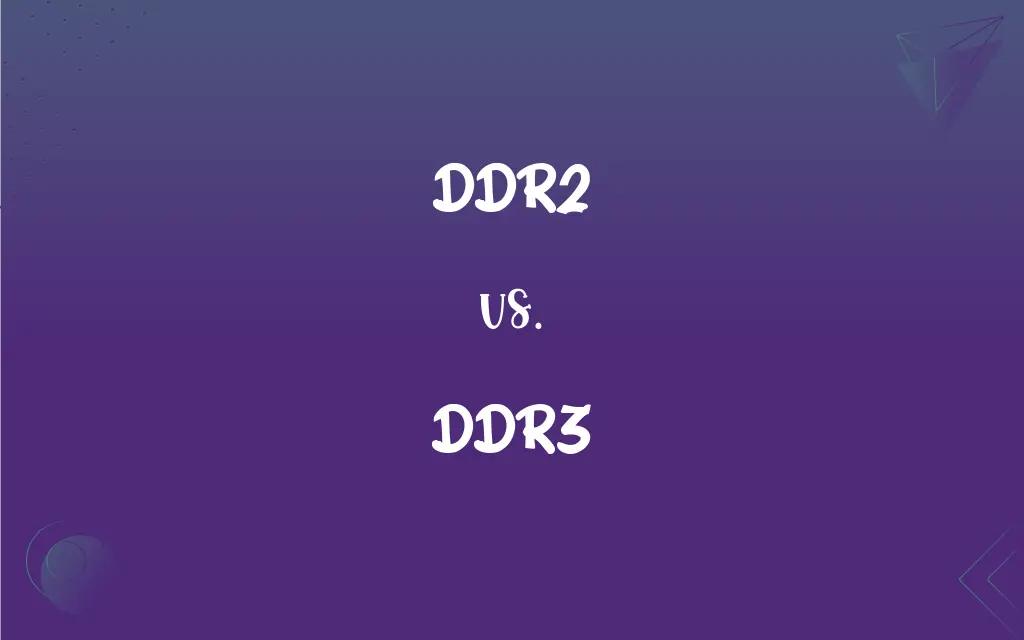DDR2 vs. DDR3: What's the Difference?
Edited by Aimie Carlson || By Harlon Moss || Published on February 26, 2024
DDR2 is an older generation of memory with lower speed and efficiency, whereas DDR3 is a newer, faster, and more efficient version.

Key Differences
DDR2, a second-generation memory technology, has lower data transfer rates and operates at higher voltages compared to DDR3. DDR3, the third generation, offers higher data transfer rates and improved efficiency at lower voltages.
The clock speed of DDR2 ranges from 400 to 1066 MHz, limiting its performance capabilities. DDR3 significantly surpasses this, with clock speeds ranging from 800 to 2133 MHz or higher.
DDR2 uses a 240-pin interface for its modules, while DDR3 also uses a 240-pin interface but is not compatible with DDR2 slots due to different key placements.
In terms of power consumption, DDR2 operates at 1.8 volts, which is higher than DDR3's more energy-efficient 1.5 volts.
DDR3 supports higher densities per module, allowing for larger memory configurations than DDR2, which is limited in maximum capacity per module.
ADVERTISEMENT
Comparison Chart
Generation
Second-generation memory technology
Third-generation memory technology
Clock Speeds
400 to 1066 MHz
800 to 2133 MHz or higher
Voltage
1.8 volts
1.5 volts
Pin Count
240-pin interface
240-pin interface (not compatible with DDR2)
Memory Capacity
Lower maximum capacity per module
Higher maximum capacity per module
ADVERTISEMENT
DDR2 and DDR3 Definitions
DDR2
Second-generation double data rate memory.
DDR2 was a significant upgrade over its predecessor in its time.
DDR3
A faster, more efficient type of memory module.
My new laptop's DDR3 RAM significantly improves its multitasking capabilities.
DDR2
Memory technology with a 240-pin configuration.
Upgrading from DDR to DDR2 required a new motherboard with a 240-pin slot.
DDR3
Third-generation double data rate memory.
DDR3 brought a noticeable performance boost over DDR2.
DDR2
Operates at a voltage of 1.8 volts.
DDR2's higher voltage requirement impacts its energy efficiency.
DDR3
Memory technology with enhanced bandwidth and lower voltage.
DDR3's lower voltage makes it more energy-efficient than DDR2.
DDR2
A type of memory module with moderate speed.
My old computer uses DDR2 RAM, which limits its performance.
DDR3
Utilizes a 240-pin interface not compatible with DDR2.
Upgrading to DDR3 often requires a new motherboard due to pin compatibility.
DDR2
DDR memory with lower data transfer rates.
DDR2's data transfer rates are insufficient for modern high-end applications.
DDR3
Supports higher densities and speeds than DDR2.
DDR3 allows for larger and faster memory configurations in modern computers.
FAQs
Can DDR2 and DDR3 be used interchangeably?
No, they are not compatible due to different pin configurations and voltages.
Is DDR3 more energy-efficient than DDR2?
Yes, DDR3 operates at a lower voltage, making it more energy-efficient.
What's the maximum capacity of DDR3 modules?
DDR3 modules can go up to 16GB per stick or more.
Which is more suitable for modern computers, DDR2 or DDR3?
DDR3 is more suitable for modern computers due to its higher performance.
When were DDR2 and DDR3 introduced?
DDR2 was introduced in 2003, and DDR3 in 2007.
Which is faster, DDR2 or DDR3?
DDR3 is faster with higher clock speeds.
What are typical applications for DDR2 memory?
DDR2 is typically used in older or less demanding computing applications.
What are the main differences between DDR2 and DDR3?
DDR3 offers higher speeds, lower voltage, and greater bandwidth than DDR2.
Are DDR2 and DDR3 slots physically different?
Yes, they have different key placements, making them physically incompatible.
What does DDR2 stand for?
DDR2 stands for Double Data Rate Type 2.
What does DDR3 stand for?
DDR3 stands for Double Data Rate Type 3.
Can I upgrade from DDR2 to DDR3 on the same motherboard?
Generally, no, as they require different motherboard slots and chipsets.
How does the latency of DDR3 compare to DDR2?
DDR3 generally has higher latency than DDR2, but its increased speed compensates for this.
What's the maximum capacity of DDR2 modules?
DDR2 modules typically max out at 4GB per stick.
Can DDR3 improve a computer's overall performance?
Yes, DDR3 can significantly enhance a computer's performance, especially in multitasking.
What voltage does DDR3 operate at?
DDR3 typically operates at 1.5 volts.
Is DDR2 still widely used?
DDR2 is mostly used in older systems; newer systems generally use DDR3 or later versions.
Is DDR3 more expensive than DDR2?
Historically, DDR3 was more expensive, but prices now depend on market demand and availability.
What are the bandwidth capabilities of DDR3 compared to DDR2?
DDR3 has greater bandwidth capabilities, allowing for faster data transfer.
What types of devices use DDR2 and DDR3?
DDR2 is used in older computers and electronics, while DDR3 is found in newer devices.
About Author
Written by
Harlon MossHarlon is a seasoned quality moderator and accomplished content writer for Difference Wiki. An alumnus of the prestigious University of California, he earned his degree in Computer Science. Leveraging his academic background, Harlon brings a meticulous and informed perspective to his work, ensuring content accuracy and excellence.
Edited by
Aimie CarlsonAimie Carlson, holding a master's degree in English literature, is a fervent English language enthusiast. She lends her writing talents to Difference Wiki, a prominent website that specializes in comparisons, offering readers insightful analyses that both captivate and inform.































































